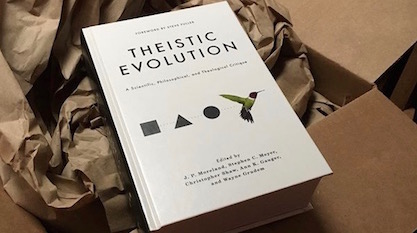 Evolution
Evolution
 Faith & Science
Faith & Science
Response to Swamidass: Confusion in a Review of Theistic Evolution

The latest issue of the theology journal Themelios includes three reviews of the volume Theistic Evolution: A Scientific, Philosophical and Theological Critique. Two of the reviews are favorable. These are by theologian Robert Yarbrough and physicist David Snoke. One, by Joshua Swamidass, is negative. Ann Gauger has already written excellent responses to Dr. Swamidass, a biologist at Washington University in St. Louis, including on the relevant science.
It’s worth engaging him, since Swamidass is the relatively rare critic of ID who works at tackling arguments for design in a substantive fashion. Therefore, this and two subsequent posts will add some additional points.
Ignoring the Case from Common Design
Swamidass states that the human and chimp genomes are 98 percent similar; he supports the argument that cites “genome similarity as evidence for common ancestry of humans and the great apes.” He apparently assumes that a high degree of genome similarity in this case necessarily indicates common ancestry. There are other possible explanations, however — for example, common design, which can produce systems with very high degrees of similarity with no needed recourse to common ancestry.
As Winston Ewert showed in his recent BIO-Complexity paper, software designers frequently re-use modules in different programs. These modules are required in order to accomplish certain needed functions. The high degree of genetic similarity between humans and chimps might be understood in the same way. Swamidass never mentions that ID proponents often invoke common design to explain such functional genetic similarities. His review makes it sound as if common descent were the only game in town.
Rebutting Arguments the Book Doesn’t Make
Swamidass’s review of Theistic Evolution only briefly discusses the science of the book. He focuses his critique on Chapter 15, “Evidence for Human Uniqueness,” by Ann Gauger, Ola Hössjer, and Colin Reeves. Swamidass writes:
The author [sic] does not explain, however, there are ten times less differences between humans and chimpanzee genomes than there are between mice and rat genomes (e.g., see The Chimpanzee Sequencing and Analysis Consortium, “Initial Sequence of the Chimpanzee Genome and Comparison with the Human Genome,” Nature 437 [2005]: 69). Even with different measures, mice and rats are much more different than chimpanzees and humans.
It’s strange that Swamidass charges the authors of the chapter with failing to discuss rat/mouse genomic differences when he himself does not mention common design, a topic that is covered extensively in the book he reviews. Given that the chapter Swamidass is critiquing is about similarities and differences between humans and apes, it does not seem quite germane to demand that the authors discuss genetic similarity between rats and mice.
As Swamidass must know, lay readers will likely assume that rats and mice share a common ancestor, and that a high degree of genetic similarity indicates common ancestry. Thus, upon learning that human and ape genomes are more similar than rat and mouse genomes, readers will assume that humans and apes must also share a common ancestor.
Evolution News answered Swamidass on this issue in great detail a couple years ago. See, “In Arguments for Common Ancestry, Scientific Errors Compound Theoretical Problems.” This was in response to a 2016 blog post Swamidass wrote. Swamidass posed there the following rhetorical question: “[W]hy is it hard to believe chimpanzees and humans are related (<1.5% codons different), when we readily accept mice and rats are related (>15% different)?” As noted already, this move faces multiple challenges.
Swamidass’s argument only makes sense if rats and mice in fact share a common ancestor. Our evidence for this is sequence similarity and anatomical similarity. Yet as pointed out in our 2016 response, “molecular clock data is all over the map when it comes to explaining the degrees of genetic similarity between mice and rats… That uncertainty doesn’t necessarily mean that mice and rats aren’t genetically related. But it does reflect much uncertainty about how to properly interpret the meaning of mouse-rat genetic similarities and differences.”
Moreover, why should the degree of similarity between two genomes settle questions of common ancestry, when common design could also produce high levels of genetic similarity?
Finally, Swamidass misses a key point made in Chapter 15. The chapter lists many functional differences between humans and chimpanzees. It’s likely that many of these differences would require multiple mutations before giving any functional advantage. We call these “multi-mutation traits.”
Multi-Mutation Traits
According to the standard view of hominid evolution, the common ancestor of humans and chimps lived about 6-7 million years ago. Within this timeframe, it’s certainly possible for traits requiring only one mutation to provide some benefit and spread through the population, eventually becoming universal, or “fixed” in the population. But according to the mathematics of population genetics, multi-mutation traits may require two or more mutations before any benefit is seen. This scenario, where multiple mutations are required to get a selectable benefit, would need tens of millions of years to arise and become fixed — perhaps as many as 200 million years.
If any of the traits specific to humans are multi-mutation traits, they are highly unlikely to arise under standard Darwinian mechanisms of random mutation and natural selection in the timescale allowed by the fossil record.
As Chapter 15 of Theistic Evolution explains :
To get a single mutation in a DNA binding site and have it become fixed would take anywhere from 1.5 million years to 6 million years, depending on whose calculations are used. If two mutations are needed to get a change in behavior or anatomy, it would take approximately between 84 and 216 million years — once again, depending on whose calculations are used. Other research using different methods merely confirms the problem.
Yet we have only 6 million years since we supposedly diverged from chimpanzees. One proposed solution is to allow the search space to include one thousand bases near any gene in the genome. That means that for a five-base binding site there are a maximum of 20,000 x 200 five-base nonoverlapping sequences or 4 million places available for a new binding site to appear. That reduces the waiting time considerably, to 7,500 years on average for a five-base binding site.
The problem is that very few binding site mutations are likely to be beneficial. Not just any old binding site will do. And most beneficial traits will require more mutations than just one. If even one essential trait required two specific coordinated mutations, the evolutionary process would stall completely, because 216 million years is too long to wait. The neo-Darwinian process cannot accomplish what is needed to explain our origin in the time available.
The chapter does argue that human and chimp genomes are more different than the 98 percent similarity statistic that is often cited (and that Swamidass cites). It suggests that the human and chimp genomes likely have a degree of similarity that is lower than 95 percent.
The argument, however, is not “Humans and apes are more dissimilar than it’s often thought, therefore common ancestry cannot explain these differences.” Rather, quoting directly from the chapter:
This chapter shows that our genetic differences are far greater than have been commonly reported, and that they reveal many functionally significant, uniquely human changes. There are too many such changes to have happened by random mutation and selection.
That is, functionally important traits would likely require multiple coordinated mutations to arise before giving any advantage. Given human population sizes and the mathematics of population genetics, it could take as many as 200 million years for a single trait requiring just two mutations to arise — That is far longer than allowed by the fossil record. A guided process could produce coordinated mutations, but random genetic change could not.
It should be noted that Chapter 15 deals with other arguments for common descent as well, such as pseudogenes and codon usage. Nevertheless, the argument in Chapter 15 does not rule out common descent as long as the process was guided. The authors of the chapter point out how it might be possible for an intelligent designer to accomplish sufficient genetic change to explain our clear differences with chimpanzees. But the evidence is clear that without intelligent design, random processes cannot accomplish the necessary changes. The amount of time available to the Darwinian mechanism to produce many of the traits encoded by these genetic differences is insufficient.
Photo: Unpacking a copy of Theistic Evolution, by Paul Nelson.

